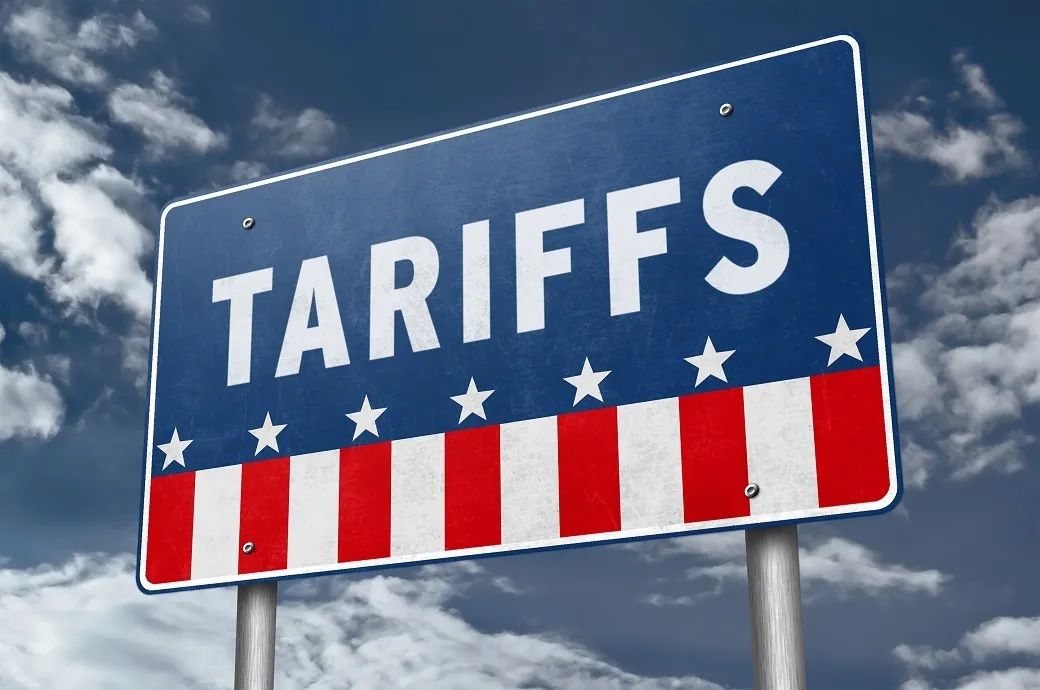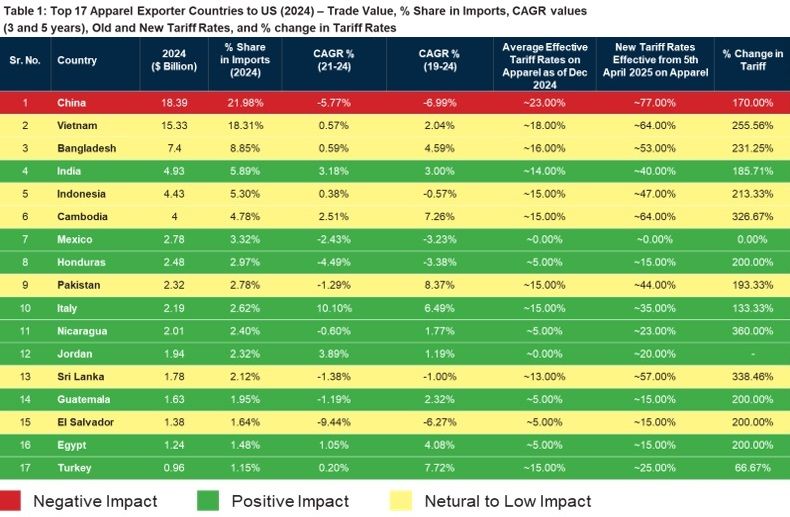
On April 2, 2025, the United States announced the implementation of comprehensive reciprocal tariffs targeting multiple nations, which include all the top apparel exporting nations to the US, except for Mexico.
In 2024, US imported apparel valued at $83.7 billion, with the top seventeen trading partners contributing approximately 89.80 per cent of this total. Around $61 billion of apparel was supplied to the US by Asian countries last year.
The revised tariff structure, which will take effect on April 5 (and April 9 for more than 10 per cent reciprocal tariffs), 2025, introduces substantial adjustments, predominantly impacting key suppliers from Asia. These measures are expected to have far-reaching effects on sourcing strategies, the restructuring of supply chains, and the dynamics of global trade.

Source: TexPro
Asia
Asian nations have been imposed with the steepest tariffs under the newly announced US trade policy. China, the United States’ leading apparel trade partner with a substantial market share of 21.98 per cent in 2024, has been hit with one of the highest tariff rates of 54.00 per cent (10% in February, followed by additional 10% in March, and 34% in April). This 54.00 per cent reciprocal tariff is in addition to the existing rate or approximately 23 per cent in December 2024.
Other prominent apparel manufacturing countries in Asia have also been significantly affected, including Cambodia (64.00% - effective tariff rate including existing plus reciprocal tariff), Vietnam (64.00%), Sri Lanka (57.00%), Bangladesh (53.00%), Indonesia (47.00%), Pakistan (44.00%), and India (40.00%).
In 2024, China remained the leading apparel exporter to the United States, with a trade value of $18.39 billion. However, a declining trend in its growth rate has been observed over the past five years, indicating the ongoing impact of trade war between the two nations.
In recent years, the United States has actively sought to reduce its reliance on Chinese merchandise. This intent is underscored by the imposition of high tariff rates on China by the Trump administration. Prior to the newly announced tariffs this year, the average effective tariff rate on apparel imports from China was approximately 23.00 per cent. The revised tariff rates represent a substantial increase of 170.00 per cent, raising the effective rate to 77.00 per cent. Considering these recent developments, it is likely that China’s substantial market share in US apparel trade will see a declining trend in the coming years.
Other key trade partners, such as Vietnam, Bangladesh, and Indonesia, have exhibited minimal to no growth in their apparel exports to the United States in recent years, leading to stable and stagnant trade flows. The newly implemented tariffs represent significant increases, with Vietnam (255.56% change), Bangladesh (231.25% change), and Indonesia (213.33% change) experiencing substantial adjustments. While these tariff changes are expected to have a moderate impact on these countries, they are unlikely to significantly influence the growth rate of apparel exports to the United States. Given that the trade values from these nations are comparatively lower than those from China, these countries must re-evaluate and adapt their strategies to navigate the evolving trade landscape and establish themselves as competitive alternatives to the Chinese market.
Among the newly imposed high tariffs, India and Pakistan face the lowest (inclusive of both existing tax and reciprocal tariff) rates in the Asian region at 40.00 per cent and 44.00 per cent, respectively. Of these two neighbouring countries, India holds a more favourable position, with nearly double the value of apparel exports to the United States compared to Pakistan, as well as the lowest tariff rate among Asian nations.
The ongoing trade agreement negotiations between India and the United States further underscore India’s advantageous standing. With a total trade value of approximately $5 billion, India ranks as the United States’ fourth-largest apparel trade partner and has achieved a modest yet steady growth rate of 3.00 per cent over the past five years. As of December 2024, the trade-weighted average effective tariff rate on US apparel imports from India was lower by approximately 6 per cent, 4 per cent, 2 per cent, and 1 per cent compared to those from China, Vietnam, Bangladesh, and Cambodia respectively. However, following the implementation of the new tariff structure on April 9, 2025, the differential in favour of India is projected to widen significantly—India’s tariff rate will be lower by 37 per cent relative to China, 24 per cent to Vietnam, 13 per cent to Bangladesh, and 24 per cent to Cambodia. This positions India in a position to potentially capture a larger market share from countries like Vietnam, Cambodia, and even China, which will be now subject to significantly higher tariffs.
Cambodia, which recorded one of the highest growth rates in apparel exports to the United States at 7.26 per cent over the past five years, is expected to experience a slowdown under the newly implemented tariff regime. The latest total tariff of 64.00 per cent—representing a considerable 326.67 per cent increase—positions Cambodia as one of the most adversely affected trade partners. This development is likely to lead to a decline in the current growth rate, potentially resulting in stagnation compared to the previously observed upward trend.
South America
The average effective tariff rate for leading South American countries under the latest tariff structure stands at 10.60 per cent, which is substantially lower than the average rate of 52.88 per cent applied to top Asian trade partners. This competitive tariff rate may create opportunities for South American countries to expand their market share in United States’ apparel trade, potentially drawing business away from Asian counterparts.
Mexico holds a significant advantage with zero tariffs on apparel exports to the United States under the USMCA agreement. Although its apparel export growth has been on a declining trajectory in recent years, the latest tariff changes could prove favourable for Mexico. With higher tariff rates imposed on key Asian trade partners, Mexico is well-positioned to capitalise on its nearshore proximity and zero-tariff benefit, thereby establishing itself as an appealing alternative in the United States market.
Countries such as Honduras, Nicaragua, Guatemala, and El Salvador collectively accounted for about 9.00 per cent of the United States’ total apparel market share in 2024. While their tariff rates have risen significantly—from 5.00 per cent to 15.00 per cent, marking a increase of 200.00 per cent for Honduras, Guatemala, and El Salvador and from 5.00 per cent to 23.00 per cent, marking a steep rise of 360.00 per cent for Nicaragua — these revised rates remain lower than those imposed on Asian countries, potentially offering a competitive edge. Furthermore, the benefit of nearshore proximity is expected to result in shorter lead times compared to Asian markets, enhancing the attractiveness of these countries.
Middle East
Jordan, Egypt, and Türkiye are key apparel trade partners of the United States from the Middle East, with export values ranging between $1 billion and $2 billion and steady growth rates of 1.19 per cent, 4.08 per cent, and 7.72 per cent, respectively. The revised tariff rates for these countries have seen significant increases: Jordan’s rate has risen to 20.00 per cent from 0.00 per cent, Egypt’s rate has increased to 15.00 per cent from 5.00 per cent, and Türkiye faces a high tariff of 25.00 per cent, up from the previous rate of 15.00 per cent.
Despite these substantial tariff increases, these Middle Eastern countries could benefit from the overall tariff adjustments, as their rates remain comparatively lower than those imposed on key Asian markets. Additionally, their geographical proximity to the United States vis-à-vis South and Southeast Asian countries offers a strategic advantage by enabling shorter lead times in supply chain operations, further bolstering their competitiveness against Asian markets.
Europe
Italy remains the United States’ sole key apparel trade partner from Europe. It was ranked as the 10th largest apparel exporter to the US in 2024, with a trade value of $2.19 billion. Over the past five years, Italy has demonstrated an impressive growth rate of 6.50 per cent, reflecting a growing demand in the United States for luxury and high-end apparel—a market segment for which Italy is renowned. Despite the recent tariff increase from 15.00 per cent to 35.00 per cent—a substantial rise of 133.33 per cent—Italy’s apparel exports to the United States are unlikely to be significantly affected. Given the premium price point of luxury and high-end apparel, consumer demand for these products is expected to remain resilient despite the higher tariffs.
The forthcoming tariff regime marks a pivotal moment for global apparel trade. While China and its Asian counterparts continue to dominate United States’ import market share, the significant tariff increases are expected to drive a shift in sourcing strategies, moving away from traditional hubs towards tariff-friendly and geographically proximate regions. For apparel brands and retailers, these developments necessitate a proactive revaluation of their sourcing models.
Source: TexPro
Fibre2Fashion News Desk (WE - MJ)